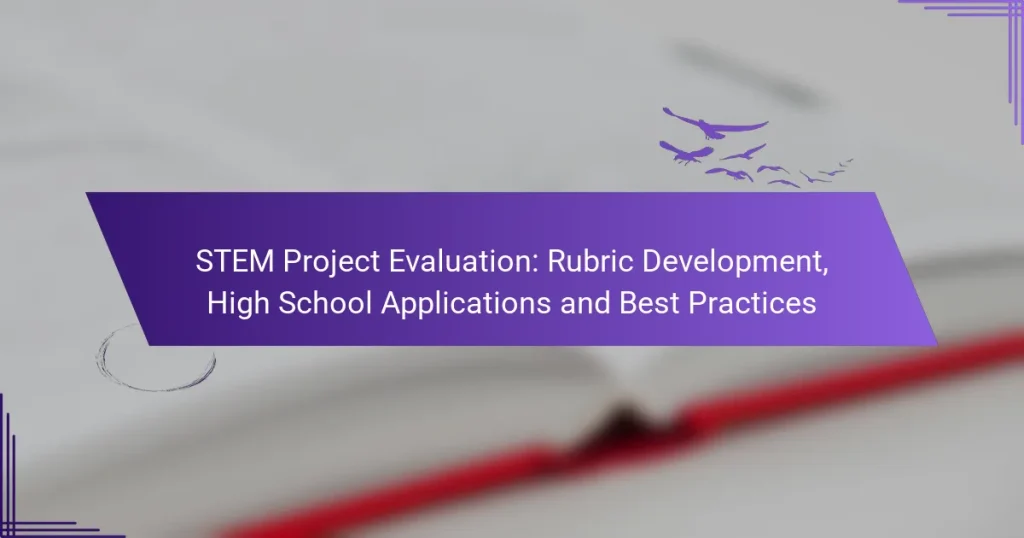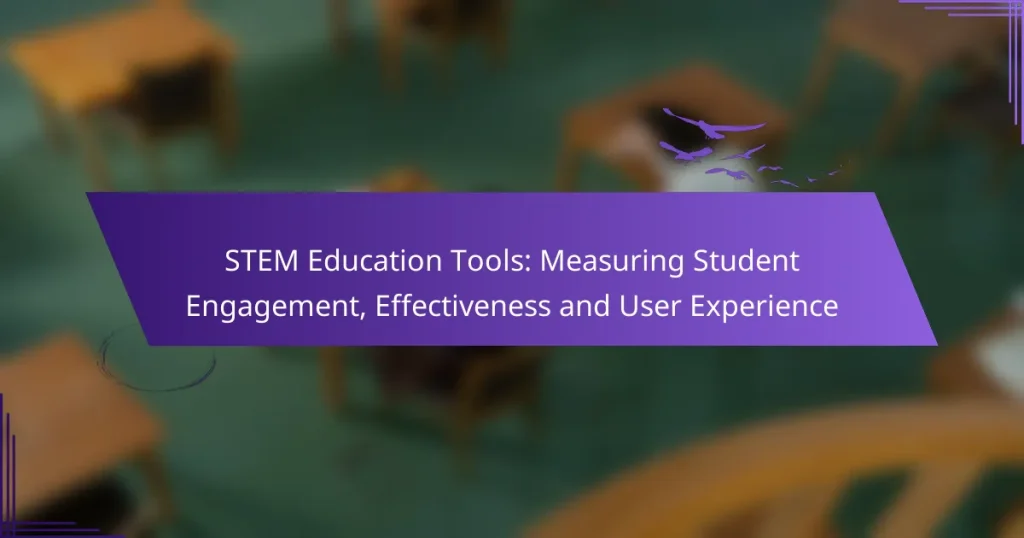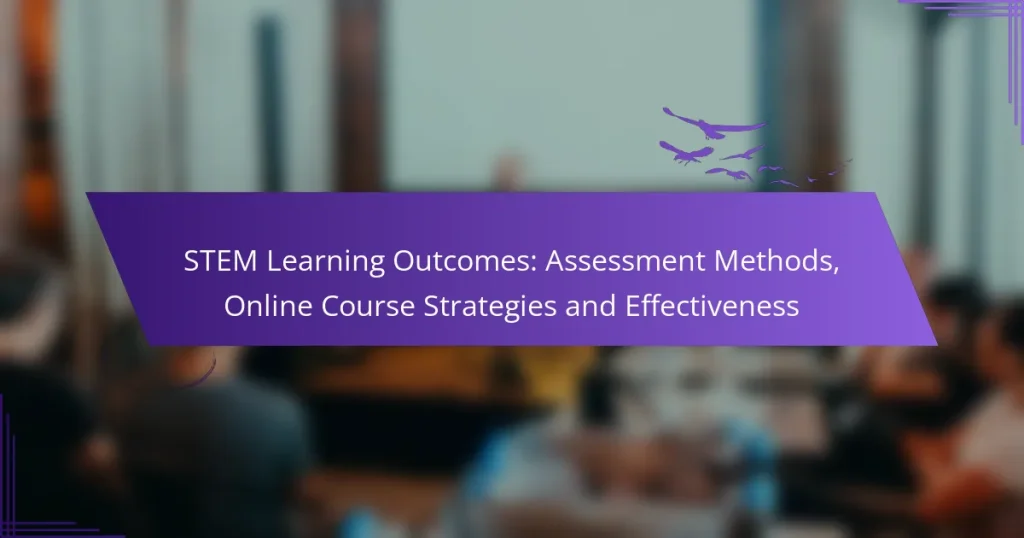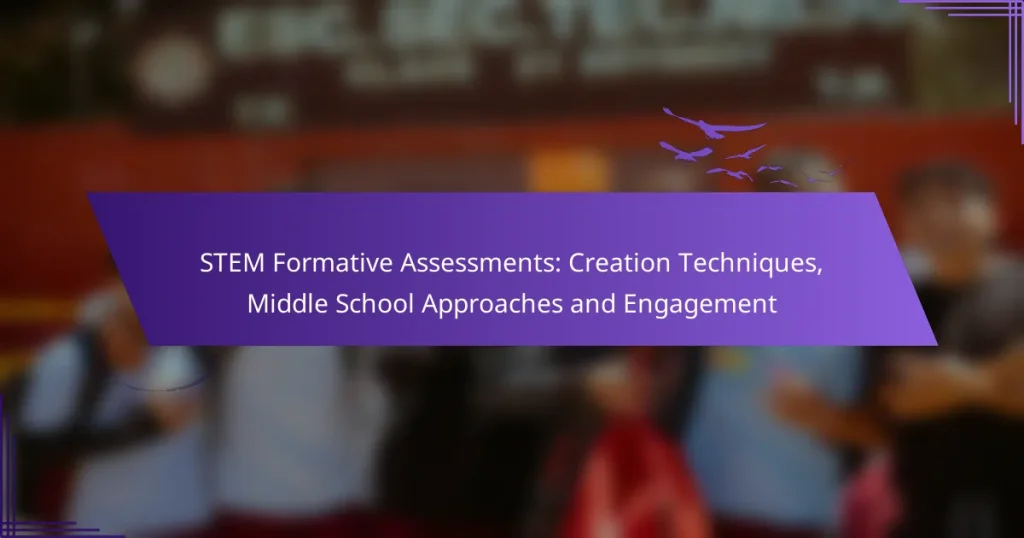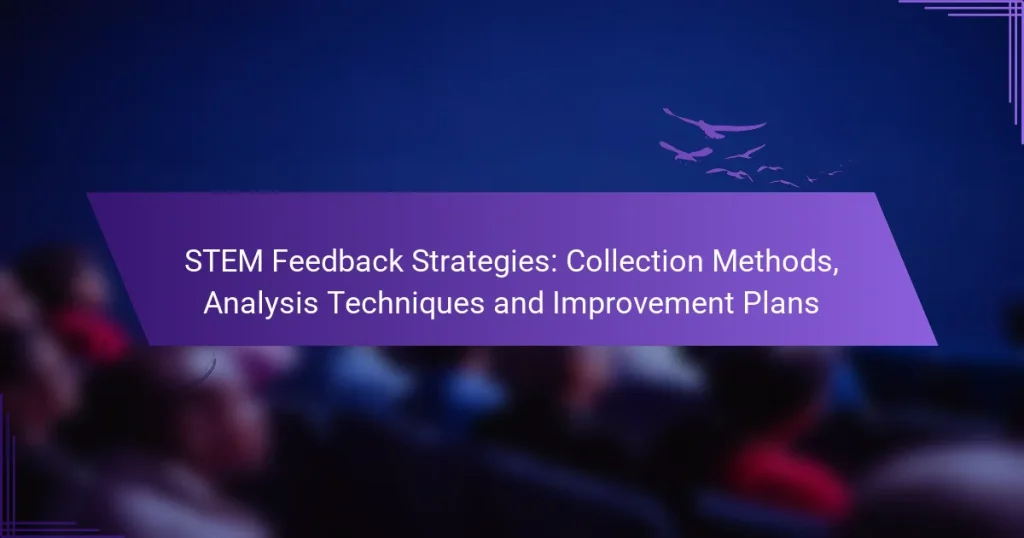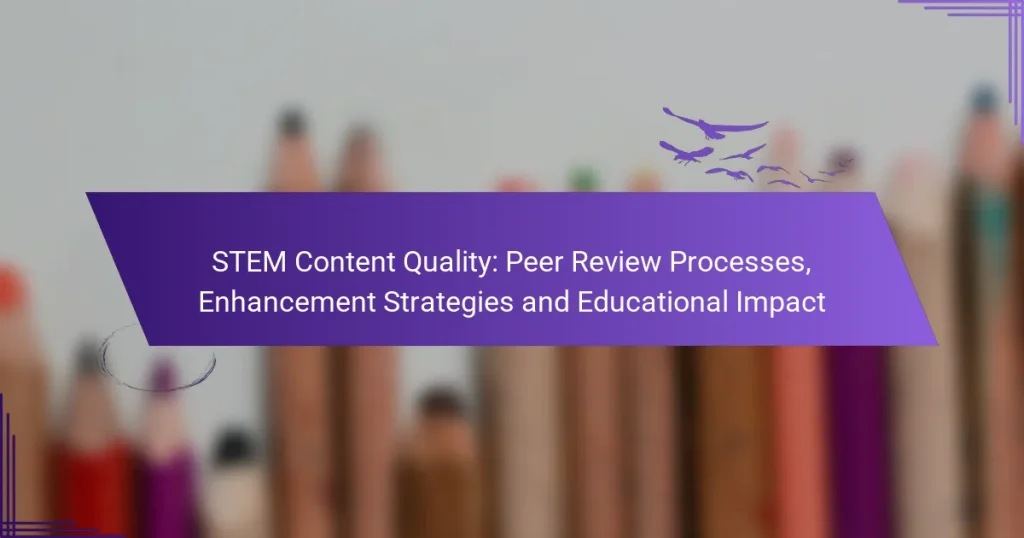Effective STEM assessment techniques are essential for evaluating students’ understanding and skills in science, technology, engineering, and mathematics. By employing these methods, educators can track learning progress and tailor their instructional strategies to better meet the needs of their students.
STEM Education Tools: Measuring Student Engagement, Effectiveness and User Experience
STEM Learning Outcomes: Assessment Methods, Online Course Strategies and Effectiveness
STEM Formative Assessments: Creation Techniques, Middle School Approaches and Engagement
STEM Content Evaluation: Impact on Student Performance, College Metrics and Analysis
STEM Feedback Strategies: Collection Methods, Analysis Techniques and Improvement Plans
STEM Content Quality: Peer Review Processes, Enhancement Strategies and Educational Impact
What are effective STEM assessment techniques?
Effective STEM assessment techniques are methods used to evaluate students’ understanding and skills in science, technology, engineering, and mathematics. These techniques help educators gauge learning progress and inform instructional strategies.
Formative assessments
Formative assessments are ongoing evaluations that occur during the learning process. They provide immediate feedback to both students and teachers, allowing for adjustments in teaching methods and learning activities. Examples include quizzes, class discussions, and interactive polls.
To maximize their effectiveness, formative assessments should be frequent and varied, targeting different skills and concepts. Educators should focus on creating a supportive environment where students feel comfortable sharing their understanding and misconceptions.
Summative assessments
Summative assessments evaluate student learning at the end of an instructional period, typically through tests or projects. These assessments measure the extent to which students have achieved learning objectives and are often used for assigning grades. Common forms include final exams, standardized tests, and end-of-term projects.
While summative assessments provide a comprehensive overview of student performance, they should be designed to reflect the curriculum and learning goals. Educators should ensure that these assessments are fair and accessible to all students, considering diverse learning needs.
Performance-based assessments
Performance-based assessments require students to demonstrate their knowledge and skills through real-world tasks. This approach emphasizes practical application, allowing students to engage in problem-solving and critical thinking. Examples include lab experiments, engineering projects, and presentations.
When implementing performance-based assessments, clear criteria and rubrics should be established to evaluate student work objectively. This method encourages deeper learning and helps students connect theoretical concepts to practical situations.
Peer assessments
Peer assessments involve students evaluating each other’s work, promoting collaboration and critical thinking. This technique fosters a sense of community and encourages students to reflect on their own learning while providing constructive feedback to their peers.
To implement peer assessments effectively, educators should provide guidelines and training on how to give and receive feedback. It is essential to create a safe environment where students feel comfortable sharing their thoughts and critiques.
Self-assessments
Self-assessments allow students to evaluate their own learning and performance, fostering self-reflection and personal responsibility. This technique encourages students to set goals and identify areas for improvement, enhancing their metacognitive skills.
Educators can support self-assessment by providing clear criteria and tools, such as checklists or reflection journals. Encouraging regular self-assessment helps students take ownership of their learning journey and develop lifelong learning habits.
How can online courses enhance STEM evaluations?
Online courses can significantly enhance STEM evaluations by providing flexible, interactive, and accessible assessment methods. These platforms leverage technology to create engaging learning experiences that can adapt to various learning styles and paces.
Interactive quizzes
Interactive quizzes are a powerful tool in online STEM courses, allowing for immediate feedback and engagement. They can include multiple-choice questions, true/false statements, and problem-solving scenarios that test students’ understanding in real-time.
To maximize effectiveness, quizzes should be designed to cover key concepts and skills relevant to the course material. Incorporating a mix of question types can help maintain student interest and cater to different learning preferences.
Virtual labs
Virtual labs simulate real-world experiments and scenarios, enabling students to conduct experiments without the need for physical materials. These labs can replicate complex STEM concepts, allowing learners to explore and manipulate variables in a controlled environment.
When implementing virtual labs, ensure they align with curriculum standards and provide clear instructions. This approach not only enhances understanding but also fosters critical thinking and problem-solving skills.
Discussion forums
Discussion forums facilitate peer-to-peer interaction and collaborative learning in online STEM courses. They provide a platform for students to ask questions, share insights, and discuss complex topics, which can deepen their understanding of the subject matter.
To encourage participation, instructors should actively moderate discussions and pose thought-provoking questions. Establishing clear guidelines for respectful and constructive dialogue can help create a positive learning community.
What criteria should be considered for STEM evaluation?
Key criteria for STEM evaluation include alignment with learning objectives, inclusivity and accessibility, and effective feedback mechanisms. These factors ensure that assessments are not only effective in measuring student understanding but also equitable and responsive to diverse learning needs.
Alignment with learning objectives
Evaluations should directly reflect the learning objectives set for the STEM curriculum. This means assessments must measure the specific skills and knowledge that students are expected to acquire, ensuring that they are relevant and purposeful.
For instance, if a learning objective focuses on problem-solving in mathematics, the evaluation should include tasks that require students to apply their problem-solving skills in real-world scenarios. Regularly reviewing and updating assessments to maintain alignment with objectives is crucial.
Inclusivity and accessibility
Inclusivity and accessibility are vital in STEM evaluations to accommodate diverse learners, including those with disabilities. Assessments should be designed to ensure all students can demonstrate their understanding without unnecessary barriers.
This may involve providing materials in multiple formats, offering extended time for completion, or allowing alternative methods for demonstrating knowledge. Ensuring that all students have equal opportunities to succeed is not just a best practice but often a regulatory requirement.
Feedback mechanisms
Effective feedback mechanisms are essential for improving student learning in STEM subjects. Evaluations should not only assess knowledge but also provide constructive feedback that helps students understand their strengths and areas for improvement.
Incorporating formative assessments, such as quizzes or peer reviews, can facilitate ongoing feedback. Additionally, timely and specific feedback can guide students in their learning journey, making it clear how they can enhance their performance moving forward.
What are the best practices for implementing STEM assessments?
Effective STEM assessments rely on clear guidelines, consistent feedback, and thorough data analysis. These best practices ensure that evaluations are meaningful, actionable, and aligned with educational goals.
Clear rubrics
Clear rubrics are essential for providing students with transparent criteria for success. A well-defined rubric outlines specific expectations for each level of performance, making it easier for students to understand what is required to achieve their desired grades.
When creating rubrics, consider including categories such as understanding of concepts, application of knowledge, and problem-solving skills. This helps students focus on key areas and allows for more objective grading.
Regular feedback
Regular feedback is crucial for student growth in STEM subjects. Providing timely and constructive feedback helps students identify their strengths and areas for improvement, fostering a growth mindset.
Incorporate feedback mechanisms such as peer reviews, self-assessments, and instructor comments. Aim for feedback to be specific, actionable, and frequent, which can significantly enhance learning outcomes.
Data analysis
Data analysis plays a vital role in assessing the effectiveness of STEM education. By systematically reviewing assessment results, educators can identify trends, strengths, and weaknesses in student performance.
Utilize tools such as spreadsheets or specialized software to track and analyze data over time. This practice not only informs instructional decisions but also helps in adjusting teaching strategies to better meet student needs.
How do different educational platforms support STEM assessments?
Different educational platforms offer various tools and features to facilitate STEM assessments, enhancing both teaching and learning experiences. These platforms provide functionalities that allow educators to create, administer, and analyze assessments effectively, catering to diverse learning needs.
Google Classroom features
Google Classroom supports STEM assessments through its streamlined interface, allowing teachers to create quizzes and assignments quickly. Educators can use Google Forms to design assessments that automatically grade responses, providing immediate feedback to students.
Additionally, Google Classroom integrates with various educational apps, enabling the use of interactive tools such as simulations and coding exercises. This versatility helps engage students in hands-on learning experiences that are crucial for STEM education.
Moodle assessment tools
Moodle offers a comprehensive suite of assessment tools tailored for STEM subjects, including quizzes, assignments, and peer assessments. Teachers can utilize various question types, such as multiple-choice, true/false, and short answer, to assess student understanding effectively.
Furthermore, Moodle’s grading options allow for detailed feedback and tracking of student progress over time. This feature is particularly beneficial for identifying areas where students may need additional support or resources.
Edmodo functionalities
Edmodo provides a collaborative platform for STEM assessments, enabling teachers to create quizzes and polls that promote student engagement. The platform’s social learning environment encourages peer interaction, which can enhance understanding of complex STEM concepts.
In addition, Edmodo allows for the integration of multimedia resources, such as videos and interactive simulations, into assessments. This capability helps to create a more dynamic learning experience, catering to different learning styles and preferences.
What emerging trends are shaping STEM assessment techniques?
Emerging trends in STEM assessment techniques focus on integrating technology, personalization, and real-world applications. These innovations aim to enhance student engagement and provide more accurate evaluations of skills and knowledge.
AI-driven assessments
AI-driven assessments utilize artificial intelligence to evaluate student performance in real-time, adapting to individual learning styles and needs. This technology can analyze vast amounts of data to provide insights into student progress and areas needing improvement.
These assessments often include automated grading systems and personalized feedback mechanisms. For example, platforms may use machine learning algorithms to assess coding skills in computer science, offering tailored exercises based on a student’s previous answers.
When implementing AI-driven assessments, it is crucial to ensure data privacy and compliance with regulations such as GDPR in Europe. Educators should also be aware of potential biases in AI algorithms and strive for fairness in evaluation.
